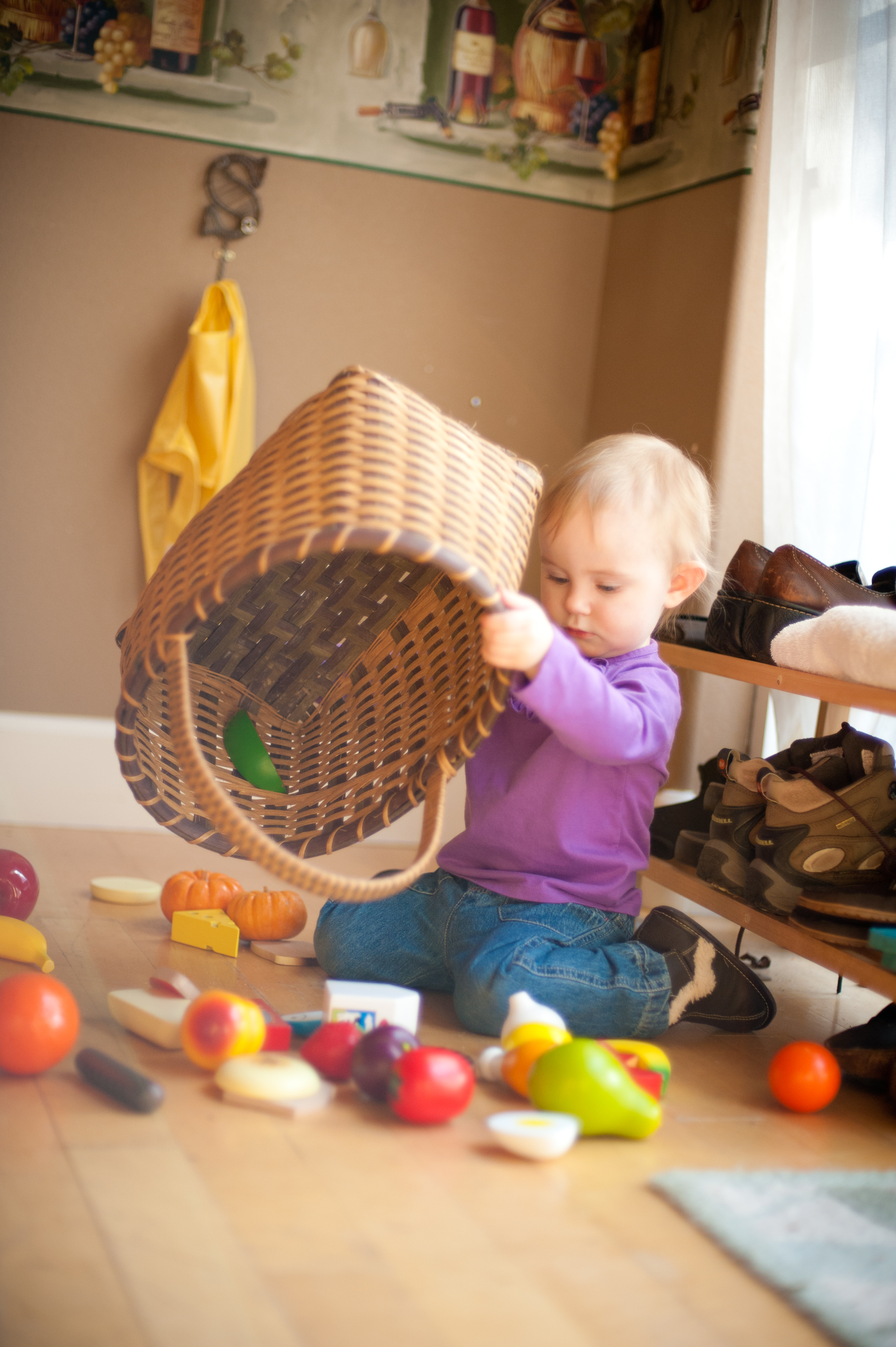Independent play can be elusive when our kids are accustomed to being entertained, read to, or otherwise catered to, but things don’t have to stay that way. You can create an environment that entices your child to engage in hours of independent play with minimal supervision and virtually no need to guide or direct them. But there are some essential steps to take to make your foray into independent play a success.
Here are my five steps to independent play:
1) Provide a safe space- First things first; if you aren’t absolutely certain that your child is safe, you’ll never be able to allow her to play alone in the other room. Safety is probably the most consistent barrier to independent play that I’ve observed in the homes of my friends, colleagues, and clients. On the other hand, when you know that your child can’t possibly pull the bookcase over on him or get into the medicine cabinet, you’ll be amazed at how much easier it is to let them do their own thing.
Here’s a list of potential hazards to be sure you’ve handled:
- Drowning- children can drown in just a few inches of water at the bottom of a bucket. Coolers with melted ice, bathtubs that didn’t get drained, and even toilets can be a drowning hazard.
- Strangulation- any cord longer than 12 inches can be considered a strangulation hazard. Be sure that all blinds cords are up and out of reach and that children don’t have access to ropes, ribbons, or strings that are longer than 12 inches.
- Fire/Electrical- covers on all electrical outlets and knob or other safety covers on your stovetop are an important precaution.
- Choking- Small items that can cause choking should be removed until children are at least three years old.
- Falling furniture- Heavy dressers and bookcases cause injury to children every year. Be sure your furniture is bolted to the wall, especially if you have a climber (and even if you don’t).
- Chemicals, medications & plastic bags- Cleaning chemicals, all medications (even over the counter) and plastic bags should all be out of reach or in a locked or childproof drawer or cabinet.
2) Provide fascinating materials- what is your child deeply interested in? If you’re not sure, find out! When children are provided with materials that spark their interest, they will explore, experiment, and play for long periods of time. However, if they still have those same five books on the shelf that never get touched, it might be time to rotate something new into that unused space. Check out my homeschool blog for ideas of inexpensive and DIY materials that can provide hours of learning.
One more note on this, don’t assume that a very young child won’t be interested in complex topics or information. You’ve seen my daughter showing off her geography knowledge. She also loves to learn about birds and frogs from my adult field guides and photo books. My friend’s two-year-old son is obsessed with hockey, and I know a six year old who loves medieval history! Don’t underestimate your child’s interests.
3) Provide ample opportunities & invite your child to play alone- I know you’re busy and you’ve got all sorts of fun and exciting activities to do, but take a moment to consider the trade off that happens when you over-schedule. Without a lot of unstructured time at home, your child doesn’t have the opportunity to develop skills in dealing with boredom or engaging in an independent self-directed activity. Instead, he’s looking over his shoulder expecting to be told what to do next. And by actively inviting your child to play alone, you’re actually supporting him in problem solving and creativity.
4) Stop interrupting your child when he’s engaged in independent play- this is a tough one, even for me. I often forget that my daughter’s activities are just as important as my own agenda. But take time this week to notice all the moments when you’re actually interrupting your child’s concentration. Notice all the times when she’s playing alone and you’re bothering her with requests to put on her shoes and get out the door.
OK, now that you’ve noticed how often you interrupt your child, try to reduce your interruptions. Sometimes all it will take is finding one more thing you need to do and waiting for your child to seek you out. Other times you may have to restructure your day or skip that trip to the park you had been planning. Just remember that by allowing your child to come to a natural conclusion of independent play, you’re cultivating a long attention span, an ability to make clear choices about what to do next, and a bunch of other benefits I’m forgetting about right now.
5) Make yourself less available & invite your child to do his work- this last step can be a tough one, especially if you’re the involved parent that I know you are. But if we want our children to develop their own skills in independence, decision-making, and engaging in meaningful self-directed work, we MUST take a step back and allow our kids to figure things out on their own sometimes. Check out this blog I wrote about how to set a clear boundary between your work and your child’s and check out that novel from the library that you’ve been meaning to read. Having a book is always a great way to remove your attention if you’d like to stay in the same room with your child. And since you’re not texting or on the computer, you’re modeling the importance of reading too! I also find that children are less likely to be distracted by my activities if I’m reading a book, rather than checking email. An open computer can be an irresistible invitation to a child.
I hope these suggestions have been helpful and I would love to hear about your own adventures in encouraging independent play. Please share your thoughts or stories in the comments below! And thanks so much for participating in our community!
Warm hugs, Shelly



This is really an excellent article, Shelly. Opportunities for concentration are so important for children. I want to talk about this in my blog on my website @ConnieLujan http://www.montessoritheory.com. this weekend. Independent work allows the child to discover themselves. I especially appreciate your thoughtful safety warnings.
Connie Ripley Lujan, Author: Montessori–Living the Good Life